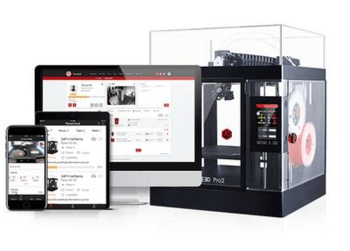Hobby 3D printing is a rapidly growing industry, and there are always new developments to keep an eye on. 3D printing constantly evolves, with new printers, materials, and software being released continuously. 3D printing has taken the world by storm, revolutionizing how people create physical objects.

Hobbyists and makers can now produce their own custom products at home, with 3D printers becoming more affordable and accessible.
The pace of technological advancement in recent years has been remarkable. New materials and methods have been developed to make 3D printing more efficient and reliable.
The most significant developments are the rise of multi-material 3D printing and the introduction of industrial-strength, filament-based 3D printing.
Multi-material 3D printing involves using different materials in a single 3D print. This allows for the creation of more complex and detailed objects than ever before, as well as the ability to mix different colors and textures.
Filament-based 3D printing is also gaining popularity. Filament-based printers use a spool of plastic filament to create objects, as opposed to the more traditional method of using a resin-based liquid.
The availability of 3D printing materials has grown exponentially in the past few years, making it easier than ever to find a material to match your project’s needs.
Advances in software and hardware have enabled 3D printers to become more accurate and precise, allowing for greater detail than ever before.
3D printing technologies have also become more affordable, allowing hobbyists to take advantage of the technology without breaking the bank.
Many lower-end 3D printers now offer high-quality prints at reasonable prices. 3D printing is also being used by hobbyists to create items that were previously inaccessible or too expensive to buy in stores.

The latest trends in hobby 3D printing.
Multi-material printing allows users to print objects with multiple colors or materials. This can be used to create objects with complex features or to add different properties to an object, such as flexibility or strength.
High-resolution printing: New printers are now capable of printing objects with resolutions of up to 20 microns, which is about the thickness of a human hair. This allows users to create incredibly detailed objects, such as miniatures or jewelry.
Intelligent design software: New design software is making it easier for users to create 3D models. These software programs include features such as automatic dimensioning, shape optimization, and collision detection.
Online communities: Online communities are an excellent resource for hobbyists seeking help, advice, or inspiration. These communities can be found on social media, forums, and websites.
These are just a few of the latest trends in hobby 3D printing. With new developments happening constantly, it’s an exciting time to be a hobbyist 3D printer.
Here are some additional details about each of these trends:
- Multi-material printing: Multi-material printing is a relatively new technology that allows users to print objects with multiple colors or materials. This can be done using a printer with numerous nozzles or a particular type of filament containing various materials. Multi-material printing can create objects with complex features or add different properties to an object, such as flexibility or strength.
- High-resolution printing: High-resolution printing is another new technology that allows users to print objects with incredibly high detail. This is made possible by using printers with very small nozzles and by using special types of filament that are designed for high-resolution printing. High-resolution printing is ideal for creating objects such as miniatures, jewelry, and medical devices.
- Intelligent design software: Intelligent design software is a type of software that helps users to create 3D models. These software programs include features such as automatic dimensioning, shape optimization, and collision detection. Intelligent design software can make it much easier for users to create complex 3D models. Even if they don’t have a lot of experience with 3D design.
- Online communities: Online communities are a great resource for hobbyists who are looking for help, advice, or inspiration. These communities can be found on social media, forums, and websites. Online communities can be a great way to learn about new 3D printing technologies, get help with troubleshooting problems, and find inspiration for new projects. Creality Cloud
Reasons why Creality 3D Printers are a great choice for 3D printing hobbyists:
- Affordable: Creality 3D Printers are some of the most affordable 3D printers on the market. This makes them an excellent option for hobbyists who are on a budget.
- Easy to use: Creality 3D Printers are designed to be easy to use, even for beginners. This makes them a great option for hobbyists who are new to 3D printing.
- High quality: Creality 3D Printers are made with high-quality materials and components. This ensures that they are durable and can produce high-quality prints.
- Large community: Creality 3D Printers have a large community of users. This community can be a great resource for getting help with troubleshooting and finding tips and tricks.
Overall, Creality 3D Printers are an excellent choice for 3D printing hobbyists. They are affordable, easy to use, high quality, and have a large community of users.
Here are some of the most popular Creality 3D Printers for hobbyists:
- Ender 3: The Ender 3 is one of the most popular 3D printers on the market. It is affordable, easy to use, and can produce high-quality prints.

- Creality Ender 3 3D printer
- Ender 3 Pro: The Ender 3 Pro is an upgraded version of the Ender 3. It includes many features that make it easier to use and produce better prints, such as automatic bed leveling and a silent stepper motor.

- Creality Ender 3 Pro 3D printer
- CR-10: The CR-10 is a larger 3D printer that can print larger objects. It is a good option for hobbyists who want to print larger objects, such as toys, models, and functional parts.

- Creality CR-10 3D printer
- CR-10S: The CR-10S is an upgraded version of the CR-10. It includes several features that make it easier to use and produce better prints, such as automatic bed leveling and a silent stepper motor.
- Creality CR-10S 3D printer
If you are looking for a superb 3D printer for your hobby, Creality is a great place to start. They offer a wide variety of printers to choose from, all of which are high quality and affordable.
Thanks,
Bullwinkle

The latest trends in hobby 3D printing, as mentioned in this passage, truly showcase the exciting advancements happening in this field. Multi-material printing, with its ability to create objects with multiple colours or materials, opens up endless possibilities for creativity and functionality. Whether it’s designing complex features or adding different properties like flexibility or strength, this trend brings a new level of versatility to hobbyist 3D printing.
The advent of high-resolution printing is another remarkable development. The ability to print objects with resolutions as fine as 20 microns allows hobbyists to bring incredibly detailed creations to life. From intricate miniatures to exquisite jewelry, the level of precision offered by high-resolution printing opens up a world of possibilities for those with a keen eye for detail.
Intelligent design software is making the process of creating 3D models more accessible and user-friendly. With features like automatic dimensioning, shape optimization, and collision detection, hobbyists can delve into the world of 3D design without extensive experience. This empowers individuals to bring their ideas to life with greater ease and efficiency.
You are right; the latest trends in hobby 3D printing are truly exciting. Multi-material printing, high-resolution printing, and intelligent design software are all making it possible for hobbyists to create more complex, detailed, and realistic objects than ever before.
Multi-material printing allows hobbyists to create objects with multiple colors or materials. This can be used to create objects with a variety of different properties, such as flexibility, strength, or conductivity. For example, a hobbyist could use multi-material printing to create a toy car that is both flexible and strong or a jewelry piece that is both conductive and attractive.
High-resolution printing allows hobbyists to create objects with resolutions as fine as 20 microns. This means that objects can be printed with incredibly fine details, such as tiny text or intricate patterns. This level of precision is perfect for creating realistic models, such as miniature buildings or figurines.
Intelligent design software makes the process of creating 3D models more accessible and user-friendly. This software includes features that help hobbyists design objects with accurate dimensions, shapes, and collisions. This makes it possible for hobbyists to create complex objects without extensive experience in 3D design.
Overall, the latest trends in hobby 3D printing are making it possible for hobbyists to create more complex, detailed, and realistic objects than ever before. This is opening up a world of possibilities for hobbyists, and it is likely that we will see even more exciting developments in the future.